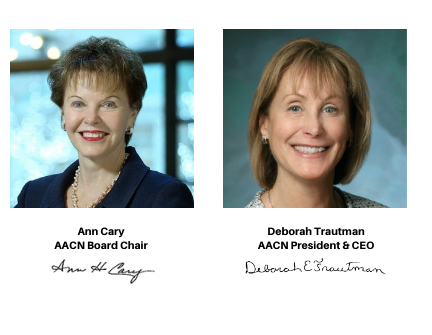When considering where to invest in nursing to realize the greatest return, AACN strongly encourages stakeholders to focus on faculty. Efforts to address the nursing shortage will fail if we do not have enough nurse educators available to prepare the next generation of care providers and to accommodate all qualified applicants looking to enroll in nursing school. In 2018, AACN reported that more than 75,000 qualified applications were not accepted by professional nursing programs due primarily to a shortage of faculty and to resource constraints. Based on an analysis of faculty employment patterns, AACN recognizes that more than one third of the current nursing faculty workforce in baccalaureate and graduate programs are expected to retire by 2025 (Fang & Kesten, 2018). Given this “brain drain” over the next 5 years, we expect today’s faculty vacancy rate of 7.2% to further tick upward (AACN, 2019).
So what can we do to address this crisis?
For starters, a successful solution to the shortage of RNs and nurse faculty will require a collaborative effort on the part of the nursing profession, the healthcare system, the federal government, businesses, foundations, and all stakeholders. Together, we must remove barriers to pursuing a nursing education, provide incentives for nurses to advance their education, and create practice environments that encourage professional practice and respect educational achievement. By focusing on creative academic-practice partnerships that value shared accountability, we can produce the next generation of nurses, nurse faculty, and nurse scientists by incorporating joint faculty appointments and greater access to preceptors into a solutions-focused plan. Clearly, more federal funding also is needed to encourage nurses to pursue faculty careers and to remove financial barriers to graduate nursing education.
At the local level, we need to generate enthusiasm around the joys of teaching and encourage more students, as well as practicing nurses, to consider what roles they can play in the nursing education arena. Those of us in academic nursing are uniquely well positioned to help spread the word about the benefits of teaching careers and to offer tips on how to transition from practice to the classroom in whatever form that takes (in-person, online, clinical, simulation, etc.) Because teaching is already an integral part of nursing, becoming a nurse educator is often the natural extension of a role in which nurses already excel. Nurses who teach enjoy the opportunity to mentor and shape patient care providers and the future leaders of our profession.
Though nurse educators are expected to juggle demands related to teaching, scholarship, research, and service, they typically express a high degree of satisfaction with their work (Arian, Soleimani, & Oghazian, 2018; HRSA, 2010). We need to do more to convey that transitioning from nursing practice to teaching roles, either full- or part-time, is a rewarding journey that requires a new level of professional development and a strong commitment to ensuring that students are well-prepared for contemporary practice.
AACN will continue to lead in raising awareness about the nursing faculty shortage while working to find solutions to addressing this critical need. At a meeting of the National Advisory Council on Nurse Education and Practice (NACNEP) held earlier this month, Dr. Di Fang, AACN’s Director of Institutional Research and Data Services, presented the latest data on the nursing faculty shortage as well as data related to faculty attrition, retirement projections, and career expectations for doctoral program graduates. This information will be incorporate into NACNEP’s 17th report to Congress: Preparing Nurse Faculty and Addressing the Shortage of Nurse Faculty and Clinical Preceptors. Keeping this issue front and center in our advocacy work is critical to raising awareness and securing greater investment in preparing future faculty.We invite you to join us this year in celebrating all those who serve in the faculty role by recognizing their invaluable contribution to sustaining a healthy nursing workforce. Together we can help make 2020 the Year of the Nurse Educator.
References
American Association of Colleges of Nursing. (2019). Special survey on vacant faculty positions for academic year 2019-2020. Accessible online at https://www.aacnnursing.org/Portals/42/News/Surveys-Data/Vacancy19.pdf.
American Association of Colleges of Nursing (2019). 2018-2019 Enrollment and graduations in baccalaureate and graduate programs in nursing. Washington, DC: Author.
Arian, M., Soleimani, M., & Oghazian, M.B. (September-October 2018). Job satisfaction and the factors affecting satisfaction in nurse educators: A systematic review. Journal of Professional Nursing, 34(5):389-399. doi: 10.1016/j.profnurs.2018.07.004.
Fang, D. & Kesten, K. (2017). Retirements and succession of nursing faculty in 2016-2025. Nursing Outlook, (5), 633-642. doi.org/10.1016/j.outlook.2017.03.003.
Health Resources and Services Administration. (2010). National sample survey of registered nurses. Accessible online at https://www.census.gov/nssrn.
World Health Organization. (2020). 2020 international year of the nurse and the midwife toolkit. Accessible online at https://www.who.int/news-room/campaigns/year-of-the-nurse-and-the-midwife-2020/get-involved.
Past Rounds with Leadership
A 2020 View of the Nursing Workforce
Building on the Past, Envisioning the Future
Academic Nursing and the Fourth Industrial Revolution
A Time for Generative Thinking
Celebrating the Power of Compassionate Care
On the Front Line of the Opioid Crisis
Galvanizing Support for Nursing Now USA
Advocating for the Future of Nursing
Monitoring Trends in Higher Education
Taking Action to Champion the PhD in Nursing
Original post https://alertarticles.info


